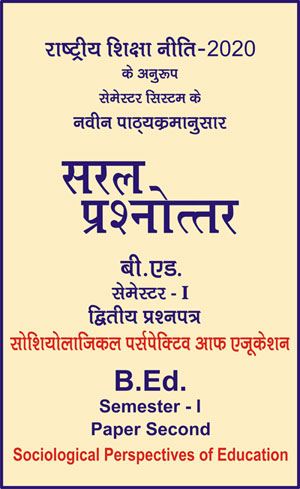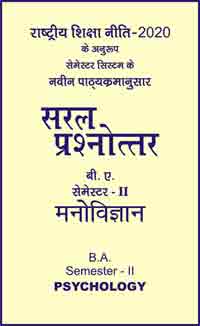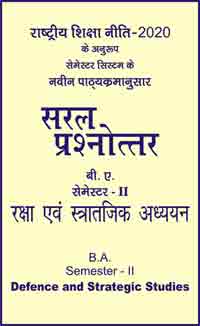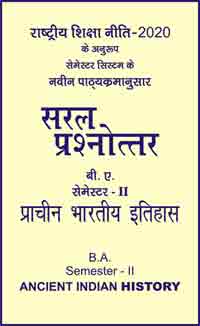|
बी एड - एम एड >> बी.एड. सेमेस्टर-1 प्रश्नपत्र-II - सोशियोलाजिकल पर्सपेक्टिव आफ एजूकेशन बी.एड. सेमेस्टर-1 प्रश्नपत्र-II - सोशियोलाजिकल पर्सपेक्टिव आफ एजूकेशनसरल प्रश्नोत्तर समूह
|
5 पाठक हैं |
|||||||
बी.एड. सेमेस्टर-1 प्रश्नपत्र-II - सोशियोलाजिकल पर्सपेक्टिव आफ एजूकेशन (अंग्रेजी भाषा मे)
Question- What do you mean by Social Change? How is it caused? Discuss the interrelationship between education and Social Change.
Or
Define the terms social and cultural change. How do these occur in any society and what are their effects ?
Or
What is meant by “cultural lag”? Is this noticeable in Indian society? Give some examples.
Or
Describe that relationship between education and social change and bring out the different aspects which this relationship may take.
Or
How can education function as an instrument of social Change? Mention some instances of this from a historical as well as a current perspective, in India.
Or
Some thinkers believe that education is a condition from bringing about social change. Do you agree with this view? Give some examples to support your viewpoint.
Or
What do you understand by cultural lag ?
Or
What do you understand by the concept of social change? How does education bring about social change?
Ans.
Meaning of Social Change
Social change is a continuous process, which may be very slow or rapid; the conscious efforts of some thinkers give it a jolt sometimes. Social change implies changes in the social structure and functions of the various units which form society, for example, changes in the structure and functions of the family, the school, the laws of marriage and inheritance, labour regulations and others. Some thinkers identify social change with cultural change—which in the narrow sense, refers to changes in customs, speech and literary forms, language, dress or hair styles. Changes in the structure of society take place at a much slower rate than changes in function. Cultural change is an important aspect of social change, and occurs in a series or cycles, influenced by other forms of culture.
Cultural changes may be of different varieties :
(a) Changes related to material culture : These changes relate to material goods and their uses. For example, the use of a car in place of a tonga, change in the use of the flush system in place of the outdoor latrine, replacing of dhoti by slacks, and other forms of visible changes.
(b) Changes in non-material culture : Here the change is in thought and the value system, for example, the idea of simplicity in marriage ceremonies in place of the three-day hospitality for the baraat and hundreds of guests. Such changes may occur in relation to one’s attitude towards harijan students in the school or attitude towards learning Hindi as a compulsory national language. These changes in attitudes would be cultural changes.
The Pace of Change : It has been observed throughout the history of civilization, and culture, that material changes take place at a much more rapid rate than non-material changes. For example, it is easy to adopt the modern comforts and symbols of civilization, with the help of wealth, cars, luxurious homes and fashions, etc., but more difficult to accept liberal social attitudes and concepts in place of tradition and superstition. Similarly, even with education, the poor in villages, cannot easily give up their old ways of thinking, and obsolete customs.
Another stumbling block to non-material change is that emotional feelings may be involved. If the old customs and traditions have emotional significance, they will not change. “Since my mother used to follow this custom, I cannot give it up, even if it has no value to me now”, is something which one may hear in tradition-bound homes, even if the members are educated.
Culture Lag : This term has been used by Ogburn to describe how one phase of culture may sometimes change more rapidly from another phase. The different rate of change is called a culture lag. For example, material changes often need certain adaptive social and material changes to go with them, but these are not made. Ogburn thinks that material culture change lies behind social change. But when the social culture does not change at the same rate as the material culture, there is maladjustment. This is visible in the dissatisfaction expressed by students of poor families, in schools. The school environment is progressive, students learn about people and ways of life in other societies, they learn about democracy, and rights of citizens and individuals, however, the same student lives in squalid surroundings, it is difficult for his mother to fill a bucket of water at the crowded, common water tap in front of the dwelling. His family may not even be able to obtain a ration card for milk for his little sisters and brothers. The difference in the material surroundings of the school and home is very great, and the contrast between the ideas taught in school and those prevalent in his home surroundings cause a great conflict in his mind: the lag is too great.
Environment Favourable To Change : Ogburn suggests that social and cultural evolution or change needs a favourable environment, and this may be brought about by three factors :
(1) Acculturation : Man takes his birth into a certain culture. He learns that culture by assimilating it from the earliest period. His home, family and society transmit cultural patterns and behaviour to him. Each generation of human beings acquires culture in a similar way from the previous generation.
(2) Diffusion : Changes in culture also come about through a diffusion or distribution of cultural traits from one culture to another. People, specially children, acquire cultural traits from others. For example, smoking cigarettes, tea-drinking, wearing westerns dress, are results of diffusion of culture.
(3) Ideas are important factors in bringing about social change and these may be found in inventions. Sometimes many intellectual, religious or scientific changes come about through inventions in the different fields of technology, art, agriculture and other areas. For example, the Renaissance in Europe which brought about tremendous social, cultural and intellectual changes, was the result of many new and explosive ideas.
The Relationship Between Education and Social Change
After independence, a great desire for change in social, economic and educational conditions has been the goal in India. The Five Year Plans, Commission, Acts and movements for progress have been set afloat to achieve what we had hoped for, after gaining independence. Every citizen of India looks forward at each Independence Day and Republic Day celebration, with a glimmer of hope that the coming years may bring what he has awaited for so long. It has been pointed out by most thinkers, that education has much to do with social change, and that this will lead to other changes. Hence we may examine the relationship between education and social change here.
This relationship functions in three ways :
(I) Education as a Condition of Social Change : Without education, there can be no social change, is what this implies, and education therefore comes prior to social change. Many reforms have been initiated in the social areas, but since the people lack education, the reforms are ineffective in practice. Hence education should bridge the gap, so that social changes may be speeded up. The uplift of backward and scheduled classes, national and emotional integration, language reforms and democratic procedures all have moved very slowly; education should try to promote favourable conditions for their success.
The most important agent of change is education, it is expected to change the attitudes and values among people and create in them a desire for progress. Education can help in increasing contemporary knowledge and in the dissemination of information on current facts. Scientific ideas can be spread among people through education. Educational leaders, planners and politicians have laid great emphasis on the power of education to usher in social changes in the country. Towards this end, there has been an expansion in education—at the school, college and university level. Teachers’ colleges, technical institutes, scientific research institutes and laboratories have been established in many parts of the country. Many foreign aid programmes in education and scientific development have been operating for several years and foreign experts in science and education have come into give assistance in their educational programmes. Refresher courses, seminars and workshops for long and short periods of days and weeks, have been held for teachers at all levels, in the country. All this in the name of education for change.
Equality of Educational Opportunity : The rapid expansion of educational facilities and educational opportunities, provided in recent years by the Centre, the States and local bodies, at various levels, has benefited the poorer classes the most, perhaps. Never before was education so inexpensive and so easily available to all. At the same time, since there is education, and practically free schooling, many hitherto unprivileged and underprivileged children now go to school.
Equality of educational opportunity also exists for those who are mentally or physically handicapped, blind, deaf and so on. Government, local body or private aided institutions exist for them; these advantages can be availed of by all who need them. However, the number of such institutes is still limited, and enough of them have not been established, specially in the rural areas.
(II) Education as an Instrument of Social Change : Any society desirous of reform and progress, needs various means and aids towards this end. Such an instrument, and one of the most important, is education. Education can impart knowledge, training and skills, as well as inculcate new ideas and attitudes among the young. Many of the old superstitious beliefs and obsolete various values which prevent progress, can, through education, be changed in favour of enlightened ideas. Much of the backwardness and poverty of the masses, as pointed out by Gandhijee is due to illiteracy and ignorance, hence education can be the instrument of rescuing them from their plight. The Basic Scheme of education was designed as an instrument of social change. In its objectives, curricula and approach we discover all the elements of a dynamic plan to change society. Gandhijee’s ashrams at Sabarmati and Sevagram were indeed places where incredulous, suspicious and doubting visitors began to believe in the potentiality of education in bringing about change.
At the present time many schools and colleges, established by Government and local bodies (as compared with those run by private bodies) often do not consider themselves to be instruments of social change, consciously. That is, they often ignore their function of promoting social change consciously through their educational programmes and activities. The teachers, too, do not always realize their function of promoting social change, by their lecturing as well as by personal example. Children take over the ideas, opinions and values of their teacher. A high degree of achievement, motivation, sensitivity, high standards of learning, of performance, of vocation, and a desire to work for the country’s unity and progress all these ideals can be inculcated in the classroom, by teachers.
(III) Education as the Effect of Social Change : If education is the result of social change, it means that social change has created a demand for education. We shall examine this by asking, what type of social changes have taken place? Are the changes caused by political upheaval, industrialization, technological advancement, religious fervour? If their effect is a great demand for education, than the nature of education should be connected with the type of social change that occurred.
Education may, therefore, have certain objectives.
Education for Awareness : It has been observed that any major crisis in a country (such as the Chinese Aggression on India in 1962, or the Indo-Pakistan War of 1965, or the Emancipation of Bangla Desh in 1971) brings to the focus of attention of people in that country, the need for awareness and alertness. More knowledge and power is needed in order to maintain the nation’s political identical and to establish its superiority. Why should our neighbours behave as they do? Can we gain more intellectual strength and know-how? How can we survive and progress as a democratic, developing nation, struggling for the prosperity of our masses? Why should we have to face aggression and conflict time and again, and have to consume our resources in establishing our identity and the justice of our cause? These are very important issues, and must agitate the thoughts of every thinking Indian. To answer them requires intelligent citizens. Patriotism is not enough—there must be deep enlightened thinking over the problems that encompass us no every side. Education of the right type is the only solution.
Education for Survival : Industrialization, scientific inventions and technology have made life more comfortable by providing trains, cars, jet planes, factories for rapid production of standardized goods, antibiotics against diseases, and many other amenities. However, all these inventions and innovations have also brought dangers with them. Pollution of air, land and water have resulted all over the planet. Farms, fields and forests have been destroyed to make room for factories and mills. Noise and smoke have altered the climate of cities. The greater the technological progress in a country, the greater the danger to life, and the lesser the chances of survival from poisonous air, water, land accidents, noise and other agents of destruction. The people in India have not yet suffered from the effects of technology and it would be well to educate the young for survival and teach about the dangers of technology. Education for survival also implies the means and methods of more food production, by modern agricultural methods and farming the waste lands in the country by liberated, trained farmers.
Student’s strikes and factions should give way to education for enlightened citizenry. An intelligent student of ten or eleven, if encouraged to think, discuss and speak freely, may perhaps be able to come out with new, original and better way of bringing about social, political and economic change in India.
|
|||||














